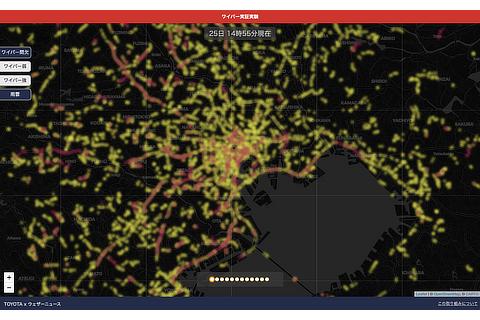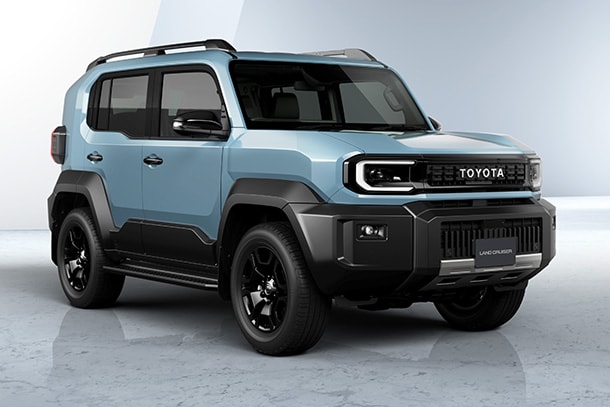Nov. 01, 2019
Toyota and Weathernews Join Forces in Joint Research Effort to Improve Accuracy of Weather Forecasts and Increase Driver Safety Using IoT and Big Data in JapanStart of Verification Test Using Wiper Data to Ascertain On-road Weather Risks
Weathernews INC. (Head Office: Mihama-ku, Chiba City; President and Representative Director: Chihito Kusabiraki; hereafter referred to as "Weathernews") and Toyota Motor Corporation (Head Office: Toyota City, Aichi Prefecture; Representative Director: Akio Toyoda; hereafter referred to as "Toyota") began a verification test*1 in Tokyo, Osaka, and Aichi on November 1, 2019 in which the conditions of roads and their surroundings are ascertained using the operating status of windshield wipers, as well as weather data. This is part of a joint research effort to increase the accuracy of weather observation and forecasts, and improve driver safety using Weathernews' weather data and the vehicle data obtained from Toyota's connected vehicles.
In this verification test, the wiper operating status of Toyota's connected vehicles being driven in the designated regions is visualized as a map and compared with actual weather data. Because wiper operating status typically corresponds to the presence or absence of precipitation, using wiper data has the potential to allow detection of precipitation that cannot be detected by standard raincloud radar. In the verification test, the relationship between the wiper data and weather data will be analyzed in detail, with the aim of detecting phenomena that could affect wiper operation in addition to detecting precipitation.
With the launch of the Crown and Corolla Sport in June of last year, Toyota has begun a full-scale rollout of connected vehicles, and going forward, nearly all passenger cars that are launched domestically will have an on-board DCM (Data Communication Module). In addition to its own observation network at approximately 13,000 locations nationwide, Weathernews makes use of 180,000 weather reports a day from users to provide highly accurate weather forecasts. Through this joint research project, both companies will provide weather data and the vehicle data obtained from connected vehicles as information "that is useful during emergencies" on a broad basis, with the goal of contributing to improved driver safety.
| *1 | For this verification test, vehicle data gathered from vehicles using Toyota's connected service undergoes statistical processing so that individuals cannot be identified. |
|---|
A Verification Test that Aims to Accurately Determine Actual Conditions Using Wiper Data and Weather Data Begins November 1
It is said that the rate of accidents during rainy weather is four times that of sunny days*2, so the presence of precipitation has a large effect on safe driving for vehicles. However, raincloud radar, which is often used to detect and predict rainy areas, has the disadvantage of being unable to detect rain resulting from rainclouds in the lower layer of the troposphere (an altitude of 2 km or below) or small raindrops such as those that form during drizzles. In such cases, it has been difficult to accurately determine areas where it is raining.
In the verification test that begins on November 1, as part of Toyota's and Weathernews' joint research initiatives, the wiper operating status of Toyota's connected vehicles being driven in the designated regions is visualized as a map and compared with actual weather data. In past cases where low rainclouds produced rain that did not show up on raincloud radar in the Kanto area, rain was instead reported by users of the "Weathernews" app*3. The user reports received matched closely with the areas where wipers were being operated, showing that wiper data can detect rain that cannot be detected using raincloud radar. We will also perform a detailed analysis of the relationship between the wiper data and weather data, and in addition to accurate detection of rainy areas, we plan to make efforts to estimate the strength of the precipitation based on the power at which the wipers are being operated, and consider using wiper data for weather forecasting.
By using wiper data to accurately ascertain the conditions of roads and their surroundings, such as precipitation and actual precipitation strength, undetectable using radar, we aim to contribute to driver safety by issuing warnings to drivers according to the situation.
| *2 | Metropolitan Expressway Company Limited, "Comparison of Number of Accidents on Sunny and Rainy Days" |
|---|---|
| *3 | Local weather reports gathered from users of the "Weathernews" app |
-
-

- Wiper and weather report data at 8:30 on July 7, 2019
- Wiper dataorangeoperating, graynot operatingWeather reportred circleslocations signifying reports about rain
-
-
-

- Special website (sample)
-
Toyota and Weathernews Join Forces in Joint Research to Improve the Accuracy of Weather Forecasts and Driver Safety
In recent years, the growing severity of weather phenomena and the resulting damage have become a societal issue, and there is an unprecedented demand for local, immediate weather information, as well as information on how to respond. To meet these needs, it is necessary to determine more detailed and accurate weather conditions in real-time. However, existing weather observation tools have limitations in their installation locations and measurement intervals.
Meanwhile, the development of IoT technology has ushered in an age where various devices are equipped with communication functions. The same is true for vehicles, and by gathering driving data and condition data from connected vehicles equipped with IoT technology, it is possible to detect phenomena that could impact their driving and behavior.
Against this backdrop, Toyota and Weathernews began an initiative that aims to use Weathernews' weather data and Toyota's connected vehicle data to improve the accuracy of weather observation and forecasts and increase driver safety. Rather than simply detecting weather phenomena directly with sensors, as is done conventionally, combining this approach with big data such as vehicle data and weather data, and analyzing it, shows potential for opening a new path for detecting the conditions of roads and their surroundings. As part of this initiative, this summer, both companies developed an AI algorithm that predicts flooded locations on roads, and performed a verification test in October of this year.





